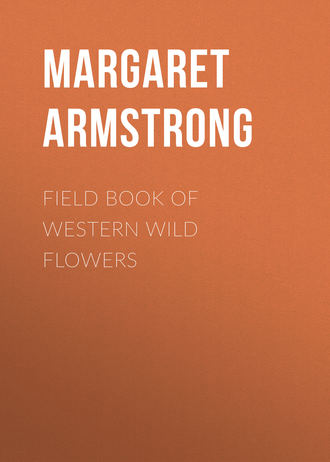 полная версия
полная версияField Book of Western Wild Flowers
There are three kinds of Trautvetteria, two American and one Asiatic.
False Bugbane
Trautvettèria grándis
White
Summer
West
A handsome plant, with a smooth, pale-green stem, from two to three feet tall, and fine large leaves, prettily cut, smooth and rather bright green, the lower ones sometimes eight inches across. The white flower clusters are large, very pretty, airy and feathery, consisting of numerous small flowers, with small petal-like sepals, usually four, and no petals, the numerous stamens, with white filaments, being the conspicuous part and forming a little pompon. The akenes are numerous, inflated and four-angled, and form a head. It is a pity that this attractive plant has such a horrid name. It grows in moist woods at Mt. Rainier and in similar places.

False Bugbane – Trautvetteria grandis.
Anemones grow in temperate and cold regions everywhere. They have no petals, but their sepals, numbering from four to twenty, resemble petals. The stem-leaves are in whorls, forming a kind of involucre below the flower. There are many kinds; some have nearly smooth, pointed akenes, some densely woolly ones, and in some the akenes have feathery tails. The name, pronounced anemòne in Latin and in English anémone, is appropriate to the fragile kinds, such as the eastern Wood Anemone, for it means "flower shaken by the wind."
Canyon Anemone
Anemòne sphenophýlla
White
Spring
Arizona
An attractive plant, eight inches to a foot tall, with pretty flowers and foliage. The flowers are white, tinged with pink, less than an inch across, often downy outside, and the head of fruit is oblong, sleek, and silky downy. This grows on dry, rocky slopes in the Grand Canyon, above the plateau. Around Tucson the flowers are less pretty, but the foliage handsomer.
Three-leaved Anemone
Anemòne deltoìdea
White
Summer
Wash., Oreg., Col.
Delicate, pale flowers, conspicuous in dark mountain woods, with slightly downy, purplish stems, from eight to ten inches tall, and pretty leaves, thin in texture, the involucre-leaves without leaf-stalks, rather light-green, dull on the upper side, paler and shiny on the under. The pretty flowers are an inch and a half to over two inches across, with five, pure-white sepals, usually two of them larger and longer than the others, and a light bright-yellow center. This is abundant at Mt. Rainier. A. quinquefòlia var. Gràyi, of the Coast Ranges, is similar, the flower often tinged with blue, the involucre-leaves with leaf-stalks.
Northern Anemone
Anemòne parviflòra
White
Summer
Northwest
A pretty little plant, with a rather hairy, reddish stem, from four to twelve inches tall, glossy, dark-green leaves, paler and downy on the under side, and flowers about half an inch across, cream-white, tinged with purple or blue on the outside; the akenes very woolly. This reaches an altitude of ten thousand five hundred feet, growing in the East and in Asia and is the smallest of the mountain Anemones.
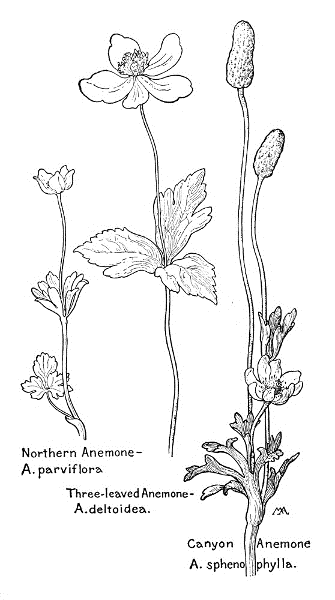
Northern Anemone – A. parviflora.
Three-leaved Anemone – A. deltoidea.
Canyon Anemone – A. sphenophylla.

Western Anemone
Anemòne occidentàlis
White
Spring
Northwest
These beautiful mountain flowers bloom in early spring, sometimes poking their pretty faces right through a hole melted in a snow-bank, and the brave little things are quite thickly covered with silky wool all over, as if to keep themselves warm. The flowers, which often bloom before the leaves expand, are about two inches across, with five to eight, cream-white sepals, tinged with blue and hairy on the outside, and are much less delicate looking than most Anemones. The stout stems are very woolly, from six to eighteen inches tall, and the leaves are beautiful, cut into numerous, very fine divisions, exceedingly feathery and pretty. The akenes have long, feathery tails and form very large, silky, fluffy heads, which are very handsome and conspicuous.
There are a good many kinds of Caltha, succulent marsh plants, of temperate and arctic regions; the leaves undivided, mostly from the base and more or less heart-shaped; the flowers with large, petal-like sepals and no petals. This is the Latin name of the Marigold.
White Marsh Marigold
Cáltha leptosépala
White
Summer
Northwest
A pretty little mountain, marsh plant with a smooth, stout, purplish stem from four to eight inches tall, and smooth, light-green leaves, often veined with purple on the under side. The flowers are an inch and a quarter across, with eight or ten, cream-white sepals, tinged with blue on the outside, and pretty golden centers of numerous stamens. This blooms at the edge of the retreating snow and reaches an altitude of twelve thousand feet. C. palústris, the Yellow Marsh Marigold, found in the Northwest and common in the East, has beautiful yellow flowers, resembling large Buttercups.

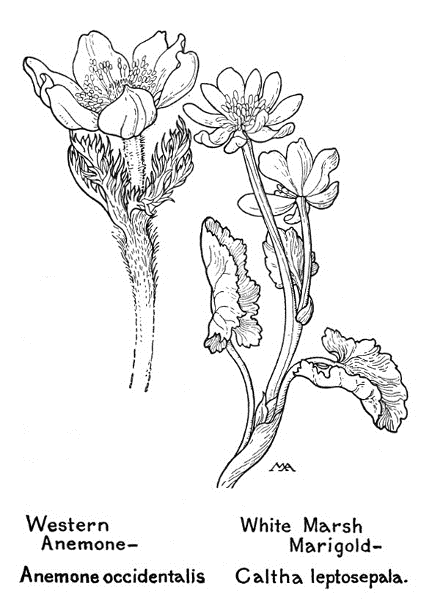
Western Anemone – Anemone occidentalis.
White Marsh Marigold – Caltha leptosepala.

There are many varieties of Clematis, or Virgin's Bower, familiar to us all, both East and West, and general favorites, widely distributed and flourishing in temperate regions; perennials, woody below, which is unusual in this family. Usually they are beautiful trailing vines, which climb over bushes and rocks, holding on by their twisting, curling leaf-stalks. The flowers have no petals, or only very small ones, but their sepals, usually four, resemble petals; the stamens are numerous. The numerous pistils form a round bunch of akenes, their styles developing into long feathery tails, and these gray, plumy heads are very conspicuous and ornamental, when the flowers are gone. The leaves are opposite, which is unusual in this family, with slender leaf-stalks, and are usually compound. Some plants have only staminate flowers and some only pistillate ones, and the appearance is quite different, the flowers with stamens being handsomer.
Virgin's Bower, Pipe-stem
Clématis lasiántha
White, pale-yellow
Spring
California
Near the summit of Mt. Lowe, and in similar places, we find this beautiful vine clambering over the rocks. The flowers measure an inch and a quarter to over two inches across and they vary in tint from almost pure white to a lovely soft shade of pale-yellow, the handsome clusters forming a beautiful contrast to the dark-green foliage. The stamens and pistils are on different plants. The flowers, leaves, and stems are all more or less velvety and the akenes have tails an inch long, forming a head, about two inches across. The flowers are often so numerous as to make conspicuous masses of pale color on canyon sides, in the Coast Range and Sierra Nevada Mountains.

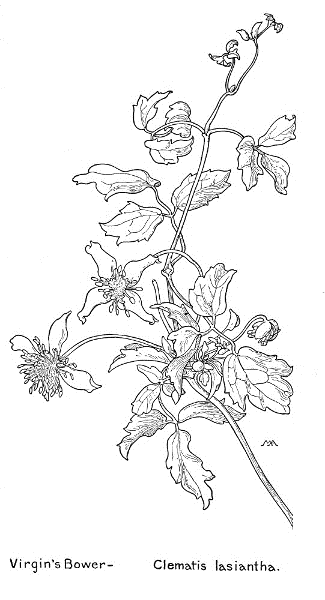
Virgin's Bower – Clematis lasiantha.
There are a few kinds of Atragene, resembling Clematis.
Purple Clematis
Atrágene occidentàlis (Clematis)
Violet, blue
Summer
West
This is peculiarly attractive, as the flowers are large and beautiful and the foliage very pretty. The leaves are divided into three, pointed leaflets, which are thin in texture, light bright-green and prettily cut or lobed, and the trailing or climbing stems are almost smooth, slender and purplish above and woody below. The flowers, which are not in clusters, measure from two to three inches across, with four, sometimes five, violet or blue sepals, spreading widely as the flower grows older, and the outer stamens are broad and resemble small petals. The flowers are followed by handsome feathery heads, which are large and silky. This pretty vine is found in the Grand Canyon, not far below the Rim, and in many mountain places. The foliage varies somewhat in different climates.
There are many kinds of Thalictrum, not easily distinguished, widely distributed, a few in the Andes, India, and Africa; perennials, with tall stems, from a short rootstock, and handsome, compound leaves; the flowers perfect or imperfect, many, small, in clusters, with four to seven sepals and no petals; the akenes tipped with the long styles and forming a head. Some of these plants have a disagreeable smell. They grow in moist places, both East and West.
Meadow Rue
Thalíctrum Féndleri
Greenish-white
Summer
West
Though its flowers are small and colorless, this plant is conspicuous for delicacy and grace. The leaves of tender green suggest the fronds of Maidenhair Fern and are almost as beautiful, while the flowers are odd and pretty. A shower of numerous, pale-yellow stamens, with purplish, threadlike filaments, falls from the center of four, greenish-white sepals and forms a charming little tassel. These tassels hang on the ends of very slender pedicels, in loose clusters. The smooth stems are from one to three feet tall and the smooth leaves are thin in texture, thrice-compound, with many, rounded leaflets, the lower leaves with long leaf-stalks. This Meadow Rue has its pistils and stamens on different plants, the flowers with tassels of stamens being prettier and more conspicuous than the small, green, pistillate ones. The variety Wrìghtii is common in Arizona.
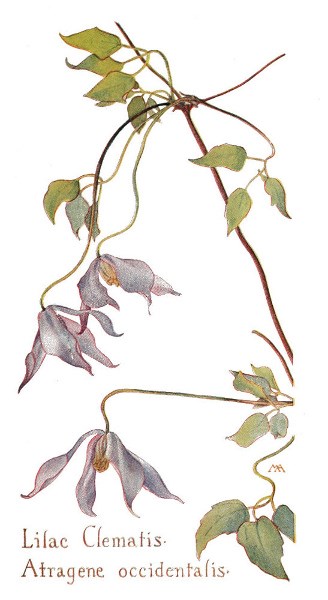
Lilac Clematis – Atragene occidentalis.
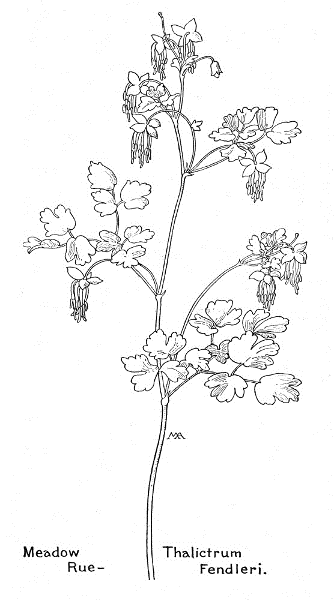
Meadow Rue – Thalictrum Fendleri.
BARBERRY FAMILY. Berberidaceae
Not a large family, widely distributed; shrubs or herbs; leaves alternate or from the root; flowers perfect; sepals and petals few, many, or none, generally in several overlapping rows; stamens on the receptacle, usually as many as the petals and opposite them; pistil one, with a short style, or none; fruit a berry or capsule.
There are several kinds of Vancouveria, perennial herbs with slender, creeping rootstocks; named after Vancouver the explorer.
Inside-out Flower, Barrenwort
Vancouvèria parviflòra
White, lilac
Spring
Wash., Oreg., Cal.
A charming woodland plant, its airy flower cluster, which has much the effect of an Alum-root, in beautiful contrast to the crisp, evergreen foliage. The large leaves are all from the root, with wiry, purplish leaf-stalks and beautifully-shaped leaflets, each an inch or more broad, pale on the under side, the older leaves dark, rich green, leathery and very glossy and the younger ones bright apple-green and thinner in texture. They form a handsome cluster, varying a good deal in size, and the general effect suggests some very crisp and sturdy sort of Maidenhair Fern. The stem is from one to two feet tall, wiry, purplish, and hairy, and bears a very loose cluster of tiny, drooping, white or lilac-tinged flowers. The six, white sepals resemble petals; the six, white petals are smaller than the sepals, lined with yellow, and there are six to nine bracts, resembling sepals, and six stamens. The minute buds are purplish and the little flowers are exceedingly pretty and odd, when we examine them closely, for the sepals turn back so abruptly from the tiny petals, and from the projecting cluster of stamens, that the name Inside-out Flower is appropriate. The fruit is a kind of capsule with many seeds. This grows in shady woods, especially among redwoods, up to seven thousand feet. V. hexándra has thinner leaflets, not evergreen, and the leaflets of V. chrysántha have white margins.
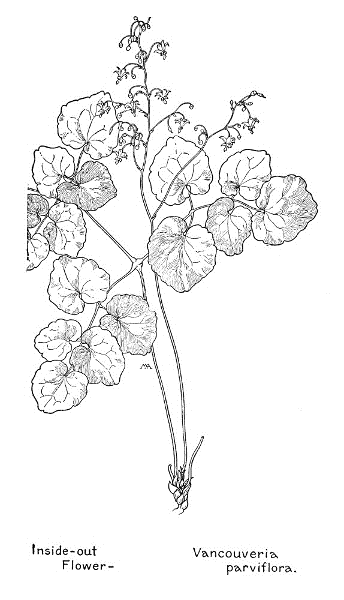
Inside-out Flower – Vancouveria parviflora.

There are many kinds of Barberry, widely distributed; shrubs, with yellow wood; the leaves often spiny and the flowers yellow; the sepals six to nine, with bracts and resembling petals; the petals six, in two overlapping rows, each with two glands at the base; the stamens six, with anthers that open by little valves like trap-doors, hinged at the top, sensitive and, when they are touched, closing around the shield-shaped stigma; the fruit a berry, with one or few seeds.
Oregon Grape, Trailing Barberry
Bérberis rèpens
Yellow
Spring
Cal., Ariz., Utah, Nev.
This does not look much like the common cultivated kinds of Barberry, for it grows close to the ground in a straggling bunch. In favorable situations it is a handsome and conspicuous plant. The leaves, with from three to seven leaflets, are stiff, prickly, and evergreen like Holly, and the yellow flowers are in clusters at the ends of the stems, with opposite bracts. The six sepals, petals, and stamens are all opposite, that is, with a petal in front of each sepal and a stamen in front of each petal. In Arizona the flowers are rather small and the clusters short, but in Utah they are far handsomer, rich golden-yellow and sweet-scented, forming clusters two inches long. The fruit is a handsome blue berry with a "bloom," the color of wild grapes, contrasting well with the foliage when it turns red in the autumn, and delicious jelly is made from them. B. aquifòlium, of Oregon and Washington, is similar, with much more beautiful, very shining leaves. B. Féndleri, of the Southwest, is from three to six feet high, the branches smooth and shiny as if varnished, the leaves with smooth edges or spiny teeth, and the flowers in numerous drooping clusters. The calyx has conspicuous, red bracts and the berry is red.

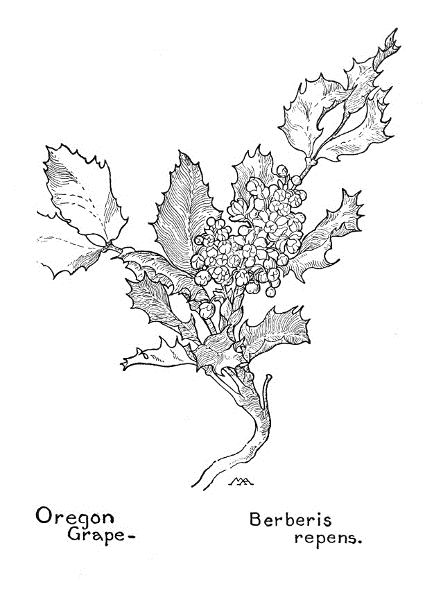
Oregon Grape – Berberis repens.
Sweet-after-Death
Áchlys triphýlla
White
Summer
Wash., Oreg., Cal.
The only kind, an attractive perennial, popular on account of its sweet-smelling foliage, which, however, is not fragrant until the leaves are dried. It has a very slender rootstock and only one large leaf, with a very long, slender leaf-stalk and three, oddly-shaped leaflets, from two to six inches across, bright-green, smooth and thin in texture, but not glossy. The single, very slender flower-stalk, from one to two feet tall, bears a crowded spike of many, tiny, scentless, white flowers, without either calyx or corolla, but consisting of a cluster of stamens, with long, threadlike filaments, the outer ones broader, and a pistil with a broad stigma and no style. The effect of the cluster is feathery and pretty and the broad leaf is very conspicuous, on account of its size and shape. The crescent-shaped fruit contains one seed, is at first fleshy, but becomes dry and leathery. This grows in the woods in the Coast Ranges, from near sea-level up to seven thousand feet. It is also called Vanilla Leaf and Deer-foot.
WATER LILY FAMILY. Nymphaeaceae
A small family, widely distributed in fresh-water lakes and streams; aquatic, perennial herbs, with thick, horizontal rootstocks, or with tubers, large, floating, or erect leaves, and large, solitary flowers, with long flower-stalks; sepals three to twelve; petals three to many; stamens six to numerous; ovary superior, stigmas distinct or united into a disk. We have no white Water Lilies in the West.
Indian Pond Lily, Spatter-dock
Nymphaèa polysépala (Nuphar)
Yellow
Summer
Cal., Oreg., Wash., Col., Wyo.
Like the eastern Spatter-dock, this is a coarse, but rather handsome and decorative plant. The leathery leaves are shaped like a rounded heart and sometimes a foot long. The cup-shaped calyx, two to four inches across, is the conspicuous part of the flower, consisting of seven to twelve, thickish sepals, yellow and petal-like, the outer greenish. There are twelve to eighteen petals, half an inch long, resembling stamens. The real stamens have dark-red anthers, but yellow pollen, and both petals and stamens are densely crowded around the ovary. The round fruit has a narrow neck, concave top, and many seeds. In quiet mountain ponds we find these yellow flowers, on stout stems standing up out of the water, the lily-pads floating idly on its surface. Indians grind the seeds into meal for porridge, or else roast them and eat them like popcorn.
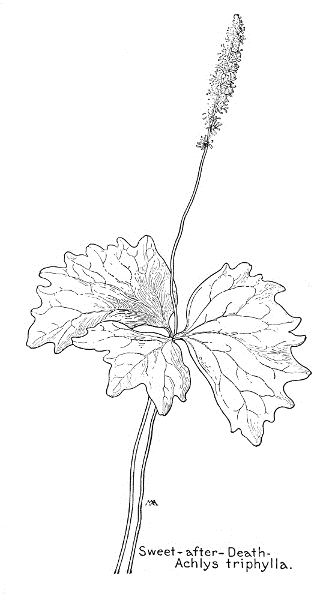
Sweet-after-Death – Achlys triphylla.
STRAWBERRY SHRUB FAMILY. Calycanthaceae
A very small family, of only two genera, one North American, one Japanese; aromatic shrubs, with opposite, toothless leaves, with short leaf-stalks, without stipules; flowers large, solitary, at the ends of leafy branches; sepals, petals, and stamens, indefinite in number, in many, overlapping series, passing one into the other, so that one cannot tell which is which, and all borne on the receptacle, which is hollow, resembling a rose-hip, almost enclosing the numerous pistils; stamens short, the inner ones without anthers; receptacle becoming a large, leathery, oblong or pear-shaped fruit, containing few or many, smooth, shining akenes.
There are three kinds of Calycanthus in this country, two of them eastern; flowers purple or red, stamens inserted in several rows.
Strawberry Shrub
Calycánthus occidentàlis
Red
Summer
California
This resembles the familiar shrub of old-fashioned gardens and the flowers have the same pleasant and elusive aroma, something like strawberries, much more spicy when crushed. The shrub is four to ten feet high, with rather coarse, harsh foliage and large, handsome flowers, two or three inches across, warm maroon in color, shading to brown and purple, with yellow stamens. This is handsome and conspicuous, because of the uncommon and rich coloring of its flowers, and grows along watercourses in the canyons of the foothills and is most common in northern California. It has many other names, such as Sweet Shrub, Carolina Allspice, Wineflowers, etc.
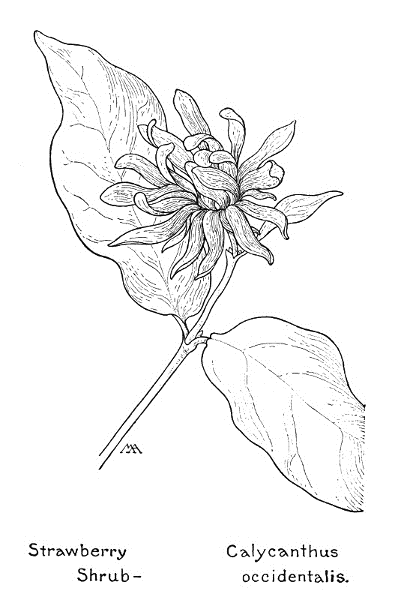
Strawberry Shrub – Calycanthus occidentalis.
POPPY FAMILY. Papaveraceae
A rather large family, widely distributed, most abundant in the north temperate zone; herbs, rarely shrubs, with milky, mostly yellow juice and narcotic or acrid properties; the leaves mostly alternate, without stipules; the parts of the flower usually all separate and distinct, borne on a top-shaped receptacle. There are usually two sepals, which fall off when the blossom opens, and usually four petals, overlapping and crumpled in the bud; the stamens are usually numerous and conspicuous, with thread-like filaments; the superior ovary becomes a many-seeded capsule.
There are only two kinds of Romneya, much alike, smooth, stout, perennial herbs, several feet high, with colorless sap, the leaves alternate and more or less divided; three sepals, each with a broad wing on the back; six, large, white petals; many stamens; the ovary covered with bristles. These plants are nowhere common, but are found from Santa Barbara south, and in lower California sometimes grow in great profusion. They are extensively cultivated and much admired abroad.
Matilija Poppy, Giant Poppy
Romnèya trichocàlyx
White
Summer
California
This is often considered the handsomest flower in the West and it would be hard to find anything more beautiful and striking than its magnificent blossoms. The plant has somewhat the effect of a Peony-bush, sometimes, in cultivation, as much as five feet high, with many smooth stems and handsome, smooth, light-green foliage, the leaves cut and lobed, those near the top with a few prickles. The splendid flowers are enormous, from five to nine inches across, with diaphanous, white petals, crinkled like crêpe tissue-paper, and bright golden centers, composed of hundreds of yellow stamens surrounding a greenish-white pistil. The blossoms remain open for several days. The hard, round buds are covered with short, brown hairs. This is the true Matilija Poppy, (pronounced Matíliha,) as it is the kind that grows in the canyon of that name, but the tremendous floods of 1914 drowned most of these beautiful plants in that locality. R. Còulteri is similar, but the buds are smooth and the stems more robust.
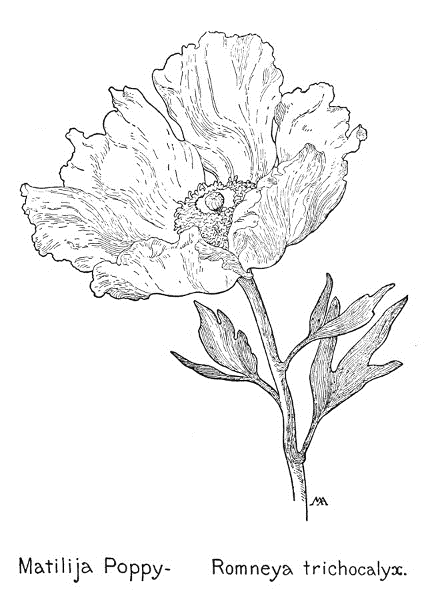
Matilija Poppy – Romneya trichocalyx.
There are several kinds of Argemone, natives of the warmer parts of America, with bitter, yellow juice, spiny-toothed leaves and large, conspicuous flowers, the buds erect; sepals two or three, with odd little horns; petals twice as many as the sepals; stamens numerous; style very short, with a radiate stigma; capsule prickly, oblong, opening at the top, containing numerous seeds.
Thistle Poppy, Milk Thistle
Argemòne híspida
White
Summer
Southwest
The prickly, bluish-green foliage of this decorative and handsome plant is thistle-like both in form and color. The leafy, branching stems, two or three feet high, are covered with dense, white or yellowish prickles and bear several lovely flowers, over three inches across, with delicately crumpled, white petals and beautiful golden centers, composed of numerous yellow stamens, both stem and leaves having a bluish "bloom." The three prickly green sepals each have a spine-like beak and form a queer-looking, three-horned bud; the pistil has a purplish, cap-shaped stigma, with six lobes, and the prickly ovary becomes a very prickly capsule. This grows in dry places and looks very beautiful and striking when we find its fragile flowers waving in the wind against a background of hot desert sand. It varies a good deal in prickliness and in the form both of plant and flower. When there is only one large flower in bloom, surrounded by a circle of prickly buds, it suggests a fairy princess, guarded by a retinue of fierce warriors. The flowers are often quite broad and flat, and then are sometimes given the prosaic name of Fried-eggs.

